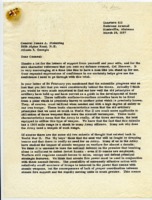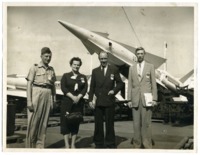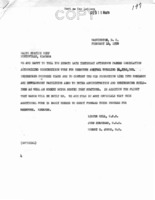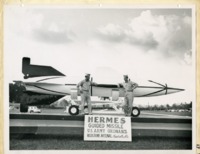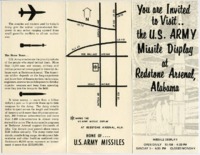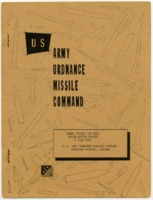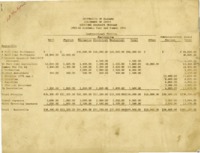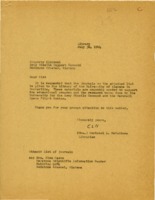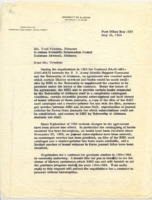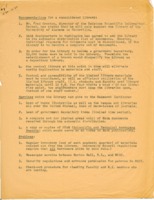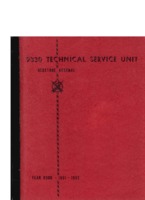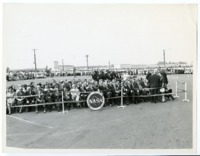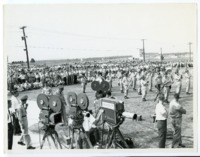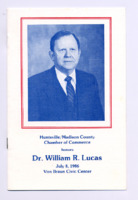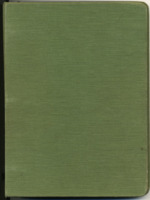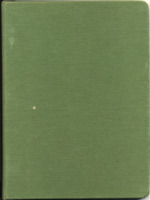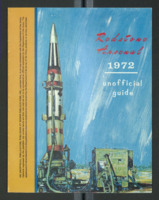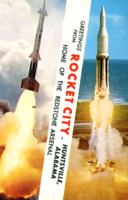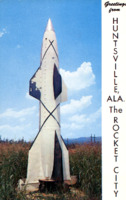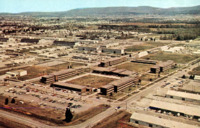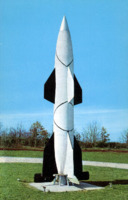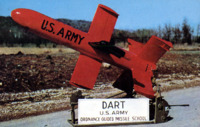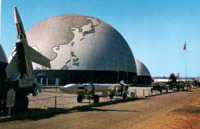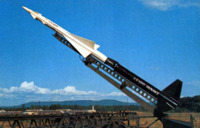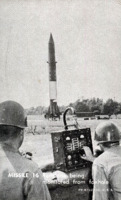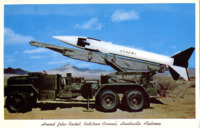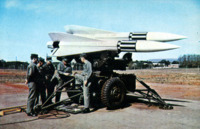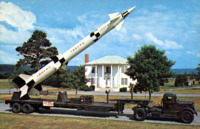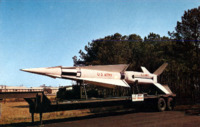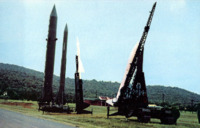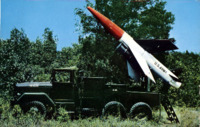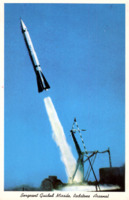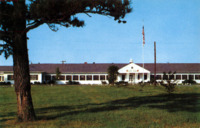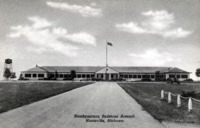
Browse Items (74 total)
Sort by:
-
Letter from Col. John C. Nickerson at Redstone Arsenal in Huntsville, Alabama, to Gen. James A. Pickering in Atlanta, Georgia.
In this letter, Nickerson thanks Gen. Pickering for his support and explains why he believes the Army is the best service branch to develop ballistic missiles. He also discusses the need for missiles in case of war with the Soviet Union. Nickerson was a staff officer at the Army Ballistic Missile Agency at Redstone Arsenal assigned to work on the Jupiter, the United States' first mid-range ballistic missile. He was arrested and court martialed for espionage in 1957 after releasing sensitive documents about the United States missile program to the press. At the time, Secretary of Defense Charles E. Wilson granted the Air Force sole authority to develop intermediate range ballistic missile systems. Nickerson disagreed with this policy, and in response, leaked documents that demonstrated the superiority of Army missiles compared to those developed by the Air Force. He eventually pled guilty to lesser charges and was suspended from the Army for one year and was fined $1,500. Dr. Wernher von Braun was among those who testified on Nickerson's behalf. -
Letter from Sen. Lister Hill, Sen. John Sparkman, and Rep. Bob Jones to Huntsville radio stations.
Addressed to stations WBHP and WFUN, the letter announces that the U. S. Senate passed "legislation authorizing construction work for Redstone Arsenal totaling $4,250,000." The letter also mentions building rocket test stations and a flight test range. -
Hermes guided missile on display.
The sign in front of the missile reads, "Hermes Guided Missile, U.S. Army Ordnance, Redstone Arsenal, Huntsville, Ala." -
"Haskins Makes Quick Change from Civilian Ph.D. to Pfc."
Clipping from the Redstone Rocket, March 2, 1954. The article highlights Haskins' background as a physicist and his role in the 9330 Technical Service Unit. -
U.S. Army Ordnance Missile Command Armed Forces Day 1961 After-Action Report.
The report outlines highlights of the Armed Forces Day, including attendance, media, and the parade lineup. The theme of the day was "Power for Peace." The report includes news clippings, a Redstone Arsenal welcome brochure, and photographs of the festivities in downtown Huntsville and at Redstone Arsenal. -
University of Alabama Statement of Costs, Redstone Graduate Program, 1963-1964.
The document outlines costs associated with laboratories and graduate coursework in math, physics, mechanical engineering, and electrical engineering. -
Letter from Christel L. McCanless at the UAH Library to the Army Missile Support Command at Redstone Arsenal in Huntsville, Alabama.
In the letter, McCanless requests the transfer of scientific and engineering journals from Redstone to support research and teaching at the University. A list of the journals is enclosed. -
Letter from George W. Croker at the University of Alabama in Tuscaloosa, Alabama, to Fred Croxton, director of the Redstone Scientific Information Center in Huntsville, Alabama.
In the letter, Croxton discusses an agreement made between the University of Alabama and Redstone Scientific Information Center (RSIC) to share library services and materials, including journal subscriptions, messenger service, and access to the RSIC facility. -
"Recommendations for a consolidated library."
The flier discusses coordination of library services between the UAH Library, the Research Institute, and Redstone Scientific Information Center. -
NASA personnel wait to greet President John F. Kennedy during his second visit to Huntsville.
Kennedy visited Huntsville on Armed Forces Day 1963. He first visited the area on September 11, 1962. -
Crowds and television cameras wait for President John F. Kennedy during his second visit to Huntsville.
Kennedy visited Huntsville on Armed Forces Day 1963. He first visited the area on September 11, 1962. -
"Huntsville/Madison County Chamber of Commerce honors Dr. William R. Lucas."
From a dinner held in honor of the retirement of MSFC director William R. Lucas in 1986. It includes a biographical sketch and photographs of Lucas. -
Charles A. Lundquist Journal No. 1.
This is the first of Charles A. Lundquist's journals in which he wrote various things during his time as a NASA scientist where he managed research on satellites and rockets at the Army Missile Ballistic Agency. It contains various notes on the satellite program, conversations with Dr. Ernst Stuhlinger, tracking flare problems, notes from the presentation at Planeto Cocoa, more notes and various equations, photoflash notes, two purposes of initial tracking, orbit distance and times, time accuracy from stars, the Reinbolt-14, questions for Dr. Schmid, the JPL Transmitter, radio schemes, a phone call transcript to Resnick, photocell questions, notes from a meeting with Dr. Wernher von Braun, the contents of the RSA Proposal, a comparison of light sources, other various phone call transcripts, multiple proposals, notes on the Whipple Report, Missile #29, photography on Missile #27, an illustration of Redstone Arsenal, RF Ignition Tests, and other various notes, proposals, equations, experiments, calls, correspondence, and tests relating to the space program. -
Charles A. Lundquist Journal No. 2.
This is the second of Charles A. Lundquist's journals in which he wrote various things during his time as a NASA scientist where he managed research on satellites and rockets at the Army Missile Ballistic Agency. It contains various notes and equations relating to the satellite program, multiple calls and conversations with NASA and military officials, notes on conferences and trips Lundquist took, test results, notes from the JPL-ABMA Conference, data from Missile #29, various proposals and test proposals, and graphs of satellite lifetimes. -
Charles A. Lundquist Journal No. 3.
This is the third of Charles A. Lundquist's journals in which he wrote various things during his time as a NASA scientist where he managed research on satellites and rockets at the Army Missile Ballistic Agency. It contains various notes and equations relating to the satellite program, multiple calls and conversations with NASA and military officials, notes on conferences and trips Lundquist took, test results, schedules, notes from the JPL meetings, the trajectory of Missile #29, and various predictions. -
Charles A. Lundquist Journal No. 4.
This is the fourth of Charles A. Lundquist's journals in which he wrote various things during his time as a NASA scientist where he managed research on satellites and rockets at the Army Missile Ballistic Agency. It contains various notes and equations relating to the satellite program, multiple calls and conversations with NASA and military officials, notes on conferences and trips Lundquist took, test results, the Hambree Research Program, lab notes, and a satellite positions map. -
Charles A. Lundquist Journal No. 5.
This is the fifth of Charles A. Lundquist's journals in which he wrote various things during his time as a NASA scientist where he managed research on satellites and rockets at the Army Missile Ballistic Agency. It contains various notes and equations relating to the satellite program, multiple calls and conversations with NASA and military officials, notes on conferences and trips Lundquist took, test results, the lunar probe and corresponding log, radar, the firing of #49, and various presentations attended. -
Charles A. Lundquist Journal No. 6.
This is the sixth of Charles A. Lundquist's journals in which he wrote various things during his time as a NASA scientist where he managed research on satellites and rockets at the Army Missile Ballistic Agency. It contains various notes and equations relating to the satellite program, multiple calls and conversations with NASA and military officials, notes on conferences and trips Lundquist took, test results, discussions on problems of missiles, power and weight summaries, various visits Lundquist received, his work load, and notes on the Explorer VII meeting at NASA headquarters. -
"Redstone Arsenal 1972 Unofficial Guide."
This guide to Redstone Arsenal contains a history of the Arsenal, complete with pictures of "Army Missiles of the Past" and details about the Army Commands stationed there, as well as descriptions of the amenities, facilities, and social opportunities available on base and in the Huntsville area. -
Greetings From Rocket City
Front: Greetings From Rocket City - Huntsville, Alabama, Home of the Redstone Arsenal
Back: Huntsville is the home of Redstone Arsenal which houses the U. S. Army Missile Command with responsibility for all Army Missiles and Rockets, the U. S. Army Ordnance Guided Missile School where soldiers receive missile training and the George C. Marshall Space Flight Center of NASA which provides the giant rocket vehicles for the nation's space program. -
Greetings From Rocket City
Front: Greetings From Rocket City - Huntsville, Alabama, Home of the Redstone Arsenal
Back: Huntsville is home of Redstone Arsenal, the Army Ordance research and development center for rockets and guided missiles. Here has centered the development of such famous rockets and guided missiles as the Nike-Ajax, Nike-Hercules, Corporal, Sergeant, Hawk, Dart, Little John, Honest John, Lacrosse, Hermes, Redstone, Jupiter and Jupiter C, which launched America's first earth satellite. -
"Greetings from Huntsville, Ala. The Rocket City"
Front: Greetings from Huntsville, Ala. The Rocket City.
Back: Huntsville, Ala., "The Rocket City"
Huntsville has earned the title "Rocket City" since the Army located most of its missile and rocket men at Redstone Arsenal. -
Aerial View of Troop Housing
Back: An aerial view of Troop Housing at the Missile and Maintenance Center and School at Redstone Arsenal near Huntsville, Alabama. -
Hermes Guided Missle
HERMES GUIDED MISSILE, HUNTSVILLE, ALABAMA. The first American-mode guided missile, first put on public display, at Huntsville, home of the world's largest rocket and guided missile research and development center, Redstone Arsenal. -
Dare Anti-Tank Guided Missile
Back: DART ANTI-TANK GUIDED MISSILE, REDSTONE ARSENAL, HUNTSVILLE, ALABAMA
This vehicle-launched, rocket propelled guided missile is designed for use by front line troops. It requires a minimum of technical training to operate, yet carries a warhead capable of defeating the heaviest known enemy armor. This versatile Army missile can deliver its warhead with pinpoint accuracy. -
U.S. Army Missile Display Area
Back: U.S. ARMY MISSILE DISPLAY AREA, Redstone Arsenal, Alabama
The massive domes house innumerable displays, individual listening devices describe and explain the functions of various Rockets and Missiles. Buttons and levers operate miniature models and allow visitors to play Astronaut. The large dome is 150' in diameter and 85' tall. It is made of vinyl coated nylon, and is kept erect by air pressure. The nylon in this one dome weighs 92,000 lbs. -
U.S. Army Ordnance "Nike" Guided Missile
Back: U.S. ARMY ORDNANCE "NIKE" GUIDED MISSILE, HUNTSVILLE, ALABAMA
Home of Redstone Arsenal, the Army Ordnance Rocket and Guided Missile Center. The Nike was America's first operational guided missile. Named after the Goddess of Victory, this weapon provides the first line of defense against atomic attack. -
Missile 16 Redstone
Front: Missile 16 Redstone being monitored from foxhole. -
Honest John Rocket
Front: Honest John Rocket, Redstone Arsenal, Huntsville, Alabama.
Back: HONEST JOHN ROCKET, REDSTONE ARSENAL
Capable of carrying both atomic and high explosive warheads, this long-range Army artillery rocket is used tactically to provide close fire support to ground combat operations. The weapon has considerably more battlefield mobility than conventional artillery and one high explosive round can deliver on the target, the demolition effect of hundreds of artillery shells. -
Hawk Anti-Aircraft Missile
Back: Field exercise maintainance of Hawk anti-aircraft missile at Missile and Munitions Center and School at Redstone Arsenal near Huntsville, Ala. -
Zeus Missile
Back: ARMY'S ZEUS MISSILE AGAINST AN OLD SOUTHERN BACKGROUND
A Zeus Missile - part of the Army's Nike-X Anti-Missile System - is posed in front of the Goddard House at Redstone Arsenal, Ala., home of the U. S. Army Missile Command. The Goddard House is an old plantation house taken over by the Army when the Arsenal was established near Huntsville in 1941. -
Missile Display & Public Picnic Area
Back: MISSILE DISPLAY & PUBLIC PICNIC AREA, Redstone Arsenal, Alabama.
This is one of the many outdoor displays provided to enlighten, encourage and inspire visitors to the area. Sights like this, provide a feeling of safety and security that you can't purchase with a can of insecticide. -
Guided Missiles
Back: THE REDSTONE, CORPORAL, NIKE-AJAX AND HONEST JOHN GUIDED MISSILES REDSTONE ARSENAL, HUNTSVILLE, ALABAMA. Redstone Arsenal is the Army Ordnance research and development center for rockets and guided missiles. It is here where the army developed its guided missiles, including the mighty Jupiter C, which launched the Explorer, the United States first Earth Satellite. -
Lacrosse Guided Missile
Back: LACROSSE GUIDED MISSILE, REDSTONE ARSENAL, HUNTSVILLE, ALABAMA.
An Army surface-to-surface artillery guided missile. The Lacrosse system consists of three basic units the missile, which is a solid fuel rocket, a launcher mounted on a standard Army truck, and a guidance station. The Lacrosse is capable of delivering a variety of warheads, at the direction of the combat commander, with precision accuracy. -
Sergeant Guided Missile
Front: Sergeant Guided Missile, Redstone Arsenal.
Back: SERGEANT GUIDED MISSILE, REDSTONE ARSENAL, HUNTSVILLE, ALABAMA.
Measuring about 30 feet in length, the Army's Sergeant is a surface-to-surface, solid propellant, ballistic guided missile possessing a very high degree of reliability and accuracy. Also highly mobile, it can be quickly emplaced and fired by a very small crew, under all conditions of weather and terrain, delivering a nuclear blow far behind enemy lines. Its highly accurate guidance system is invulnerable to ony known means of enemy counter-measures. -
Redstone Aresenal
Back: REDSTONE ARSENAL southwest of Huntsville, Alabama.
Site of the nation's largest ordnance, rocket, and guided missile research. -
Headquarters, Redstone Arsenal
Front: Headquarters, Redstone Arsenal, Huntsville, Alabama.
